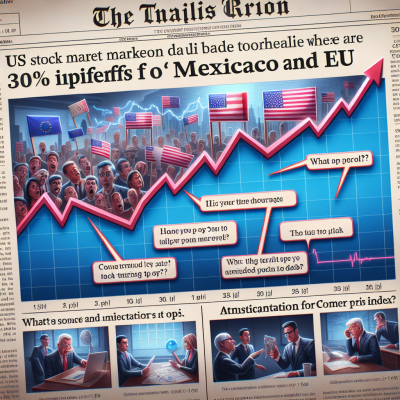
Market Reels from Surprise Tariff Announcement
U.S. stock futures slipped on Thursday after a major policy announcement from former President Donald Trump sent ripples through global markets. Trump unveiled a sweeping 30% tariff on all imports from Mexico, a move extended to key European Union sectors as well. The aggressive trade action rekindled fears of a global trade war and left investors bracing for volatility ahead of the release of key U.S. inflation data.
Wall Street Opens Cautiously as Tariff Tensions Rise
The markets were caught off guard by the sudden imposition of tariffs, pushing U.S. stock futures into negative territory during early trading. Dow Jones Industrial Average futures dropped by over 200 points, while S&P 500 futures and Nasdaq 100 futures followed closely behind with losses near 0.5%.
The move represents Trump’s most protectionist policy shift since his time in office, and sparked sharp criticism from trade partners and economists who fear retaliatory measures. European stocks also saw red, with Germany’s DAX and France’s CAC 40 opening lower.
Impact on Key Sectors
The tariffs are expected to have a widespread impact across various industries. On top of raising consumer prices, they also threaten to disrupt supply chains dependent on cross-border trade. Particularly affected sectors include:
- Automotive: vehicle makers like General Motors, Ford, and Volkswagen anticipate production hurdles due to costlier imported parts.
- Agriculture: U.S. farmers worry about retaliatory tariffs from Mexico and the EU, risking billions in exports.
- Retail: Many retailers that source goods from Europe or Mexico face potential price hikes that could squeeze margins.
Several multinational companies have spent years building international supply chains that hinge on duty-free agreements. The sudden tariff hike places significant pressure on corporate profitability and business planning.
What’s Driving the Tariff Decision?
While specific motivations behind Trump’s announcement remain speculative, insiders point to a strategic economic position designed to bolster American manufacturing. The former president has repeatedly advocated for “America First” trade policies and may be using tariffs as economic leverage during crucial political months.
Still, economists warn that such abrupt policy moves can backfire, leading to slower global growth and trade conflicts that ultimately harm U.S. consumers and businesses.
All Eyes on U.S. CPI Data
Market nerves are also heightened ahead of the release of the U.S. Consumer Price Index (CPI) data, scheduled for later this week. The CPI reading will offer critical insight into inflation trends as the Federal Reserve calibrates its monetary policy path.
Inflation as a Market Catalyst
A hotter-than-expected CPI figure could reinforce expectations of prolonged high interest rates, spooking risk assets like equities. Conversely, softer inflation data might encourage speculation of potential rate cuts later in the year—offering a breather for the embattled markets.
Analysts Forecast Mixed Results
Current consensus estimates suggest:
- Headline CPI: Expected to rise by 0.3% month-over-month.
- Core CPI: Stripping out food and energy, expected at 0.2% monthly growth.
Traders will be closely watching Fed commentary following the data release to parse any hints about potential shifts in monetary policy.
Global Markets Await Response
The geopolitical friction caused by Trump’s tariff decision may spark a new round of trade negotiations or retaliatory measures from Mexico and the EU. Already, officials from Brussels and Mexico City voice strong discontent, vowing to consider “proportionate responses” if the new measures take effect.
Foreign Exchange and Commodities React
Currency markets saw the U.S. dollar gain slightly on safe-haven demand, but the Mexican peso fell sharply against the dollar amid uncertainty. The euro dipped marginally, reflecting pressure on European economic indicators.
Meanwhile, oil prices edged lower on fears of reduced global economic activity, while gold gained modestly due to its appeal as a risk-averse asset during geopolitical turmoil.
Investor Sentiment Near-Term
Although Trump’s tariff announcement jolted Wall Street, markets may stabilize depending on upcoming economic data and policy responses. However, increased volatility remains likely as investors digest both inflation updates and geopolitical developments.
Key Takeaways for Investors
- Remain diversified: Global trade risks may impact a wide swath of industries; diversification helps mitigate sector-specific shocks.
- Watch Fed signals: Inflation data and resulting Fed guidance will significantly impact market trajectories.
- Monitor global developments: Retaliation from trade partners could impact agricultural commodities, tech exports, and consumer goods.
The Road Ahead
With economic policy once again in the spotlight, investors must balance short-term volatility with long-term trends. The combination of rising geopolitical tension, protectionist trade policies, and inflation uncertainty presents a challenging market environment.
Still, those with a sound investment strategy and risk management approach may find opportunities amid the turbulence. As markets await both CPI data and global political reaction, staying informed and agile will be key to navigating the days ahead.


Leave a Reply